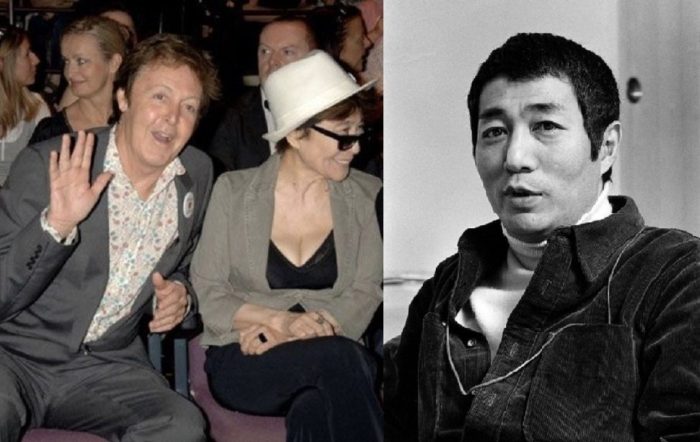Both Terayama and Yoko came of age in the early 1950s, which made them significantly older than The Beatles and other sixties icons. Nonetheless, they came to symbolize and influence the counterculture of the era.
The dynamic they shared was the drive to fuse avant garde ideas with mass entertainment. That would leave them open to charges of ruthless ambition and “selling out.”
Commercialism had always been suspect to the high priests of the avant garde. André Breton, prime mover of the pre-war surrealists, gave Salvador Dali the anagrammatic nickname “Avida Dollars” on account of the healthy income his paintings generated.
To Terayama, who idolized Dali and was later to visit him in Spain, and to Yoko commercial success part of the project. It meant that the message was getting across.
Notoriety and outrageousness were also part of the formula. They both understood the mesmerizing power of the mass media and courted controversy of any sort. The global phenomenon of pop music was an obvious channel for projecting their personas.
Terayama’s Toki niwa haha no nai ko no yo ni was a million seller for singer Carmen Maki, and several of the hundreds of other songs he wrote are well-known today. The music itself is accessible and catchy.
Yoko fused herself with the biggest band in the world at the height of their fame, sitting in on their recording sessions and releasing her own music with their help – some of it unsettlingly weird, some in a more conventional vein. For example –
There can be no better example of the fifties seeding the sixties than Yoko, in October 1966, bringing a request from John Cage to The Beatles. Cage wanted to use a Lennon-McCartney song manuscript in a book he was writing. Yoko, living in London at the time, visited the house of the Beatle who was the most knowledgeable about the avant garde.
That was Paul McCartney, who had absorbed all kinds of unusual influences from the artistically inclined family of his girlfriend, Jane Asher. He had attended a lecture by Italian composer Luciano Berio in 1966 and regularly sought out concerts featuring works by Berio, Cage and Karlheinz Stockhausen.
This was at a time when John Lennon was still in his conservative rock’n roller phase and considered that avant garde was “French for bullshit.” George Harrison came up with a pun – “avant garde a clue.” Ringo’s opinion is unknown.
In the end McCartney was not willing to hand over any Beatles material, so Yoko turned her attention to Lennon instead.
Imagine a different outcome. Imagine that the most avant garde Beatle at the time did in fact agree to supply Yoko with a song manuscript. Imagine that the bond created between them developed into a romantic liaison.
Imagine that Yoko collaborated with McCartney on his unreleased musique concrète piece from 1967, Carnival of Light, rather than with John Lennon on Revolution No.9 in 1968.
Imagine that it was Paul and Yoko that appeared naked together on a record cover; that they did a week long “bed-in”; that Paul sang Helter Skelter in Toronto while Yoko writhed in a laundry sack in front of him.
Imagine that Yoko became a permanent member of McCartney’s band Wings, featuring on keyboards and howling banshee backing vocals; that they are still performing together today.
Imagine. Imagine. Imagine.
There is no bird than can fly higher than the human imagination. Shuji Terayama


